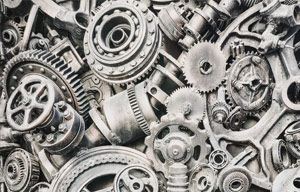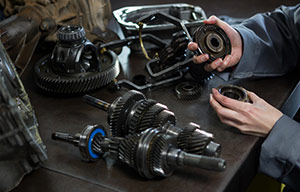1. Undang-Undang.
1.1 Undang-Undang Mesin Berbahaya.
The Dangerous Machines (Regulation) Act 1983. Undang-undang ini mengatur perdagangan, produksi, pasokan, distribusi dan penggunaan, produk industri sebagai mesin berbahaya dengan maksud untuk mengamankan kesejahteraan tenaga kerja yang mengoperasikan mesin tersebut dan untuk pembayaran kompensasi atas kematian atau cedera tubuh yang diderita oleh pekerja mana pun saat mengoperasikan mesin tersebut, dan untuk hal-hal yang berhubungan dengannya atau yang bersifat insidental.
1.2 Undang-undang Pabrik.
The Factories Act. Undang-Undang ini dubuat untuk mengkonsolidasikan dan mengubah undang-undang yang mengatur tenaga kerja di pabrik-pabrik di India yang memuat ketentuan tentang kesehatan, keselamatan, jam kerja, cuti dan kesejahteraan pekerja; memeriksa staf untuk pabrik; proses berbahaya di pabrik; mempekerjakan orang muda (anak-anak dan remaja); dan sanksi bagi yang melanggar ketentuan undang-undang.
1.3 Undang-undang Perlindungan Konsumen.
Consumer Protection Act. Undang-Undang Perlindungan Konsumen merupakan Undang-Undang untuk memberikan perlindungan terhadap kepentingan konsumen, menetapkan otoritas untuk administrasi dan penyelesaian sengketa konsumen yang tepat waktu dan efektif serta hal-hal yang berhubungan dengannya atau insidental.
1.4 Undang-Undang Bea dan Cukai.
Customs Act. Secara garis besar, Undang-Undang ini mengatur lalu litas arus barang impor dan ekspor
2. Regulasi Teknis.
(Draft) The Machinery and Electrical Equipment Safety Order, 2020.
Definisi “machinery/mesin” menurut standar IS 16819:2018/ISO 12100:2010”: adalah “assembly” beberapa komponen yang dirakit dan dilengkapi dengan atau dimaksudkan untuk dipasang sistem penggerak yang dihubungkan dengan komponen, dimana setidaknya salah satu kompenen tsb bergerak menjadi sebuah “machinery/mesin” untuk penggunaan fungsi tertentu.
Mesin diklasifikasikan dalam kategori risiko berikut:
- Kelas 1 - Risiko rendah: Mesin dengan bahaya kecil bagi pengguna / operator.
- Kelas 2 - Risiko sedang: Mesin dengan bahaya besar yang dapat menyebabkan cedera serius atau cacat sementara bagi pengguna / operator.
- Kelas 3 - Risiko tinggi: Mesin dengan bahaya kritis yang dapat menyebabkan cacat, cacat permanen pada anggota badan atau kematian.
Ketentuan (order) ini tidak berlaku untuk mesin dan peralatan listrik yang sudah dinotifikasi oleh Pemerintah Pusat berdasarkan peraturan teknis lainnya dan untuk mesin dan peralatan listrik untuk ekspor. Ketentuan pada drat order ini antara lain:
- Kesesuaian dengan Standar
- Type A standards (i) IS 16819:2018/ISO 12100:2010, (ii) IS 16504 (Part-1):2019/IEC 60204-1:201, dan (iii) IS/IEC 61508 : PART 1 : 2010.
- Type B Standards – adalah standar generik ynag berkaitan dengan aspek keamanan sebagai perlindungan yang digunakan pada mesin dan (atau) peralatan listrik. Standar dapat dilihat pada bagian “Annexure-I” dokumen ini.
- Type C Standards – Standar keamanan mesin berkaitan dengan persyaratan keselamatan terperinci untuk mesin atau kelompok mesin tertentu dan/(atau) peralatan listrik. Standar dapat dilihat pada bagian “Annexure-II” dokumen ini.
- Persyaratan:
- Persyaratan penandaan (Marking) pada mesin dan peralatan listrik:
- Jenis / Merk / Model mesin yang terdaftar atau Jenis yang diperiksa dan disertifikasi;
- Nama dan alamat pabrikan;
- Nama merek atau Merek Dagang di mana mesin dan (atau) peralatan listrik dipasarkan, jika ada;
- Nomor seri atau nomor Batch mesin dan (atau) peralatan listrik;
- Persyaratan dokumen teknis (Technical File)
- Persyaratan penandaan (Marking) pada mesin dan peralatan listrik:
- Sertifikasi wajib (Compulsory Certification): Setiap mesin dan (atau) peralatan listrik harus memiliki tanda standar dengan lisensi dari Biro Standar India.
- Pengawasan Pasar: Pengawasan pasar sebagai instrumen untuk memastikan penerapan standar yang ditetapkan.
Ketentuan ini berlaku untuk mesin dan/atau peralatan listrik yang tercantum pada bagian “List of Machinery and Electrical Equipment” pada dokumen ini.
3. Standar.
Standar Kemanan (Safety) Mesin dan Peralatan Listrik.
- IS 16819:2018/ISO 12100:2010 Safety of Machinery General Principles for Design-Risk Assessment and Risk Reduction
- IS 16504 (Part-1):2019/IEC 60204-1:2016 Safety of Machinery- Electrical Equipment of Machines Part 1 General Requirements
- IS/IEC 61508: PART 1: 2010 Functional Safety of Electrical — Electronic — Programmable Electronic Safety-Related Systems Part 1— General Requirements
- IS 16501:2017 Safety of machinery - Functional safety of safety - Related electrical, electronic and programmable electronic control systems
- IS 16502 ( Part 2) : 2017/ IEC 61496-2 : 2013 Safety of Machinery - Electro-Sensitive Protective Equipment Part 2 Particular Requirements forEquipment Using Active Opto-Electronic Protective Devices
- IS 16503 ( Part 3) : 2017/ IEC 61310-3 : 2007 Safety of Machinery- Indication Marking and Actuation Part 3 Requirements for the Location and Operation of Actuators
- IS 16504 ( Part 32) : 2017/ IEC 60204-32 : 2008 Safety of Machinery-Electrical Equipment of Machines Part 32 Requirements for Hoisting Machines
- IS 16503 ( Part 1) : 2017/ IEC 61310-1 : 2007 Safety of Machinery- Indication Marking and Actuation Part 1 Requirements for Visual Acoustic and Tactile Signals
- IS 16594 ( Part 1) : 2017/ IEC 61496-1 : 2012 Safety of Machinery - Electro-Sensitive Protective Equipment Part 1 General Requirements and Tests
- IS 16936 : 2018 / IEC TR 62513 : 2008 Safety of Machinery Guidelines for the Use ofCommunication Systems in Safety Related Applications
- IS 16503 ( Part 2) : 2017/ IEC 61310-2 : 2007 Safety of Machinery - Indication Marking and Actuation Part 2 Requirements for Marking
- IS 16807 : 2018 / ISO 19353 : 2015 Safety of Machinery Fire Prevention and Fire Protection
- IS 16808 : 2018 / ISO 14159 : 2002 Safety of Machinery Hygiene Requirements for the Design of Machinery
- IS 16809 ( Part 1) : 2018 / ISO 14122-1 : 2016 Safety of Machinery Permanent Means of Access to Machinery Part 1 Choice of Fixed Means and General Requirements of Access
- IS 16809 ( Part 2) : 2018 / ISO 14122-2 : 2016 Safety of Machinery Permanent Means of Access to Machinery Part 2 Working Platforms and Walkways
- IS 16809 ( Part 3) : 2018 / ISO 14122-3 : 2016 Safety of Machinery Permanent Means of Access to Machinery Part 3 Stairs Stepladders and Guard-Rails
- IS 16809 ( Part 4) : 2018 / ISO 14122-4 : 2016 Safety of Machinery Permanent Means of Access to Machinery Part 4 Fixed Ladders
- IS 16810 ( Part 1) : 2018 / ISO 13849-1 : 2015 Safety of Machinery Safety Related Parts of Control Systems Part 1 General Principles for Design
- IS 16810 ( Part 2) : 2018 / ISO 13849-2 : 2012 Safety of Machinery Safety Related Parts of Control Systems Part 2 Validation
- IS 16811 : 2018 / 14210 : 2015 Safety of Machinery Guards General Requirements for the Design and Construction of Fixed and Movable Guards
- IS 16812 : 2018 / ISO 14119 : 2013 Safety of Machinery Interlocking Devices Associated with Guards Principles for Design and Selection
- IS 16813: 2019 / ISO 14118 : 2017 Safety of Machinery Prevention of Unexpected Start-Up
- IS 16814: 2018 / ISO 13857 : 2008 Safety of Machinery Safety Distances to Prevent Hazard Zones Being Reached by Upper and Lower Limbs
- IS 16815 : 2019 / ISO 13855 : 2010 Safety of Machinery Positioning of Safeguards with Respect to the Approach Speeds of Parts of the Human Body
- IS 16816 : 2019 / ISO 13854 : 2017 Safety of Machinery Minimum Gaps to Avoid Crushing of Parts of the Human Body
- IS 16817: 2018 / ISO 13851 : 2002 Safety of Machinery Two-Hand Control Devices Functional Aspects and Design Principles
- IS 16818 : 2018 / ISO 13850 : 2015 Safety of Machinery Emergency Stop Function Principles for Design
- IS 16912 : 2018 / ISO 21469 : 2006 Safety of Machinery Lubricants with Incidental Product Contact Hygiene Requirements
- IS 16834 (Part 1) : 2018 / ISO 14123-1 : 2015 Safety of machinery - Reduction of risks to health resulting from hazardous substances emitted by machinery - Part 1: Principles and specifications for machinery manufacturers
- IS 16834 (Part 2) : 2018 / ISO 14123-2 : 2015 Safety of machinery - Reduction of risks to health resulting from hazardous substances emitted by machinery - Part 2: Methodology leading to verification procedures
- IS 16835 (Part 1) : 2018 / ISO 13856-1 : 2013 Safety of machinery - Pressure-sensitive protective devices - Part 1: General principles for design and testing of pressure-sensitive mats and pressure-sensitive floors
- IS 16835 (Part 2): 2018 / ISO 13856-2 : 2013 Safety of machinery - Pressure-sensitive protective devices - Part 2: General principles for design and testing of pressure-sensitive edges and pressure-sensitive bars
- IS 16835 (Part 3) : 2018 / ISO 13856-3 : 2013 Safety of machinery - Pressure-sensitive protective devices - Part 3: General principles for design and testing of pressure-sensitive bumpers, plates, wires and similar devices.
- IS 16569: 2018 / ISO 11429 Ergonomics- System of Auditory and Visual Danger and Information Signals
- IS 16563 (Part 2) : 2017 / ISO 9355-2 Ergonomic Requirements for the Design of Displays and Control Actuators Part 2 Displays
- IS 16563 (Part 3) 2017 / ISO 9355-3 Ergonomic Requirements for the Design of Displays and Control Actuators Part 3 Control Actuators
- IS 16572 : 2017 / ISO 14738 : 2002 Safety of Machinery - Anthropometric Requirements for the Design of Workstations at Machinery
- IS 16562 ( Part 1) : 2017 / ISO 15536-1 : 2005 Ergonomics - Computer Manikins and Body Templates Part 1 General Requirements
Standar Lainnya.
- IS : 9474- 1980 Specification for Principles of Mechanical Guarding of Machinery
- IS 12136:1987 Classification of Printing Machines
- IS 1476:2000 Performance of Household Refrigerating Appliance — Refrigerators With Or Without Low Temperature Compartment
- IS 15750:2006 Household Frost-Free Refrigerating Appliances - Refrigerators Cooled by Internal Forced Air Circulation— Characteristics and Test Methods— Specification
- IS 12699:1989 Selection, Installation, Operation and Maintenance of Jet Centrifugal Pump Combination — Code Of Practice
- IS 1391:1992 Room Air Conditioners
Daftar 32 Standar ISO tentang keselamatan mesin yang diadopsi sebagai Standar India oleh BIS dapat dilihat disini.
4. Lembaga Berwenang.
Biro Standar India (Bureau of India Standards) memiliki tugas dan fungsi untuk keserasian perkembangan kegiatan standardisasi, penandaan dan sertifikasi mutu barang dan untuk hal-hal yang berhubungan dengannya atau yang terkait dengannya.
Biro Efisiensi Energi (Bureau of Energy and Efficiency) memiliki tugas dan fungsi untuk membantu dalam mengembangkan kebijakan dan strategi dengan penekanan pada pengaturan mandiri dan prinsip-prinsip pasar dengan tujuan utama untuk mengurangi intensitas energi ekonomi India dalam kerangka keseluruhan Undang-Undang Konservasi Energi, 2001. Ini akan dicapai dengan partisipasi aktif dari semua pemangku kepentingan, menghasilkan adopsi efisiensi energi yang dipercepat dan berkelanjutan di semua sektor.
5. Informasi Lainnya.
- National Capital Goods Policy 2016
- Making Safe Machines a Standard In India
- Quality Rules in India: Trade,Technical Regulations and Consumer Protection











